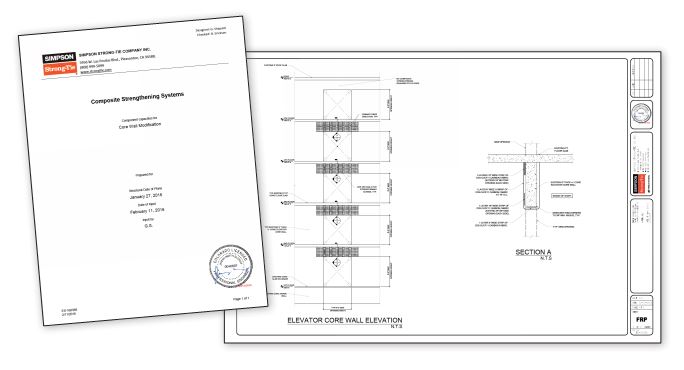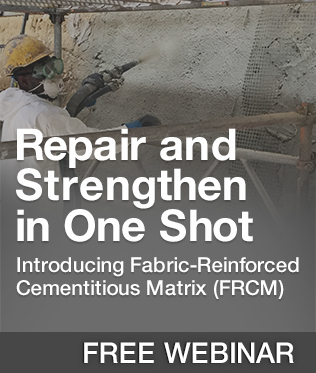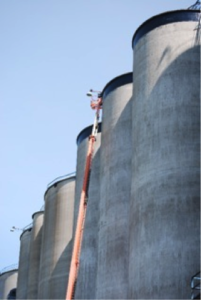The primary benefit of fiber-reinforced polymer (FRP) systems as compared with traditional retrofit methods is that significant flexural, axial or shear strength gains can be realized using an easy-to-apply composite that does not add significant weight or section to the structure. Many times it is the most economical choice given the reduced preparation and labor costs and may be installed without taking the structure out of service. However, it is important to make sure the composite is properly designed following industry standards in order to ensure that it is the right product for the application.
To provide you with a better understanding of the topic, it’s important to dispel some common myths and misconceptions that you might hear about FRP:
1. “FRP can solve all my retrofit and strengthening problems”
Composite strengthening systems are another tool for your toolbox, providing a possible solution to certain specific retrofit problems. However, they can’t do everything, and there are times when they may not be able to meet the project requirements. Simpson Strong-Tie’s design team will work with you to prepare a feasibility study to ensure suitable solutions for your application. One very important check when strengthening a structure is to verify that the existing, unstrengthened capacity is capable of resisting a certain percent of the newly applied loads. The following equations are strengthening limit checks that should be considered. These checks will sometimes determine how much additional strength the FRP composites are capable of providing to the existing structure.
Note: These checks do not apply to wind or seismic strength.
2. “FRP is 10 times stronger than steel”
Although the ultimate tensile strength of some FRP dry fibers can exceed the yield strength of mild reinforcing bars (60 ksi) by up to 10 times, there are two main reasons an engineer should not assume that using FRP will provide 10 times the capacity of steel. First, the cured composite properties, not the dry fiber properties, are more relevant when designing with FRP composites. The ultimate tensile strength of cured composites will be more on the magnitude of two to three times stronger than 60 ksi (not 10 times stronger). Second, the ultimate tensile strengths of FRP systems occur at ultimate strain. When full design calculations are performed, the FRP design strain and resulting FRP strength will often be much lower after accounting for all possible failure modes and all recommended reductions based on durability testing and/or environmental reduction factors. Code limits often govern design over published ultimate strength properties.
For this reason, it is not good practice to size the required area of FRP using:
AFRP = (Arebar x fy rebar) / ffu FRP
 3. “FRP can triple the flexural capacity of the member or replace all the corroded steel”
3. “FRP can triple the flexural capacity of the member or replace all the corroded steel”
It may be possible to achieve higher increases depending on member properties, but the following are some good rules of thumb when estimating the amount of strengthening that can be provided by FRP: flexural = 40%, shear = 20%, axial = 20%. Design is usually governed by the existing strength check, the FRP debonding strain (can’t develop infinite tension capacity through the bond line), or a ductility check (flexural φ factor based on strain in rebar at section failure).
4. “Stamped calculations and drawings were submitted, so it must have been designed properly”
Often, the FRP design engineer may make various assumptions in the design calculations, and the EOR (reviewer) should ensure that the FRP is designed “correctly” and verify that any assumptions made by the FRP engineer are accurate. Note that Simpson Strong-Tie calculations have an “Assumptions” section to make it is very easy for the EOR to identify where we took educated guesses.
Simpson Strong-Tie Can Help
We recognize that specifying Simpson Strong-Tie® Composite Strengthening Systems™ is unlike choosing any other product we offer. Leverage our expertise to help with your FRP strengthening designs. Our experienced technical representatives and licensed professional engineers provide complimentary design services and support – serving as your partner throughout the entire project cycle. Since no two buildings are alike, each project is optimally designed to the Designer’s individual specifications. Our pledge is to address your specific condition with a complete strengthening plan tailored to your needs, while minimizing downtime or loss of use, at the lowest possible installed cost.
Your Partner During the Project Design Phase
During the Designer’s initial evaluation or preparation of the construction documents, Simpson Strong-Tie can be contacted to help create the most cost-effective customized solution. Simpson Strong-Tie Engineering Services will work closely with the Design Engineer to provide all the necessary information required to design the system. The solution we deliver will include detailed design calculations for each strengthening requirement and design drawings with all the necessary details to install the CSS.
Why Use Simpson Strong-Tie Design Services?
- To assess feasibility studies that will help ensure suitable solutions to your application
- To receive customized FRP strengthening solutions
- To work with our trained contractor partners to provide rough-order-of-magnitude (ROM) budget estimates
- To collaborate during the project design phase
- To receive a full set of drawings and calculations to add to your submittal
- To maintain the flexibility to provide the most cost-effective solution for your project
- To gain trusted technical expertise in critical FRP design considerations

Learn more: Webinar – Introducing Fabric-Reinforced Cementitious Matrix (FRCM)
In this free webinar we dive into some very important considerations including the latest industry standards, material properties and key governing limits when designing with FRCM.
Continuing education credits will be offered for this webinar.
Participants can earn one professional development hour (PDH) or 0.1 continuing education unit (CEU).

For complete information regarding specific products suitable to your unique situation or condition, please visit strongtie.com/css or call your local Simpson Strong-Tie RPS specialist at (800) 999-5099.






